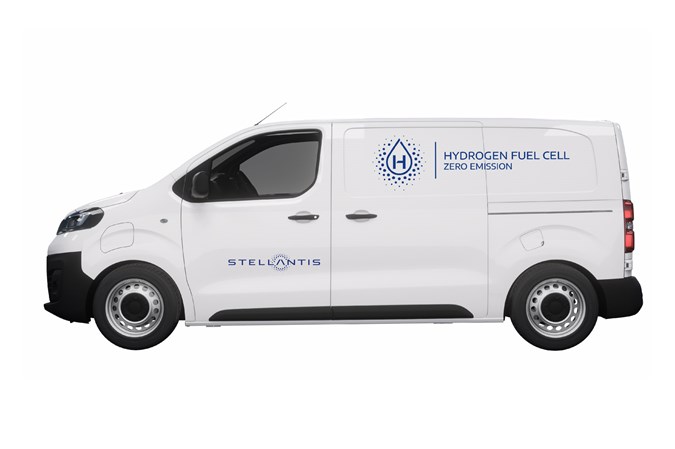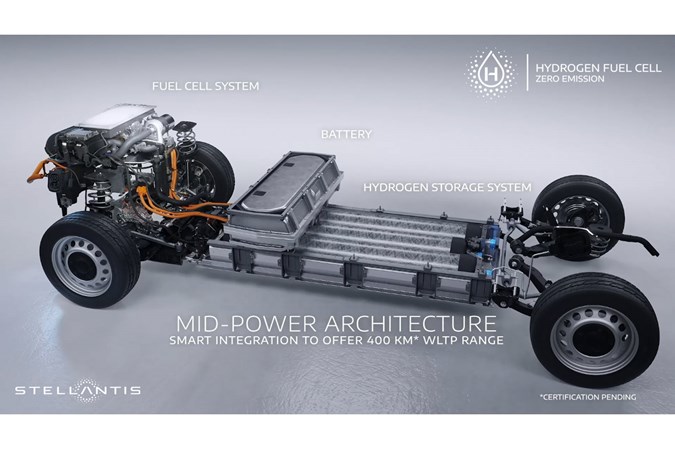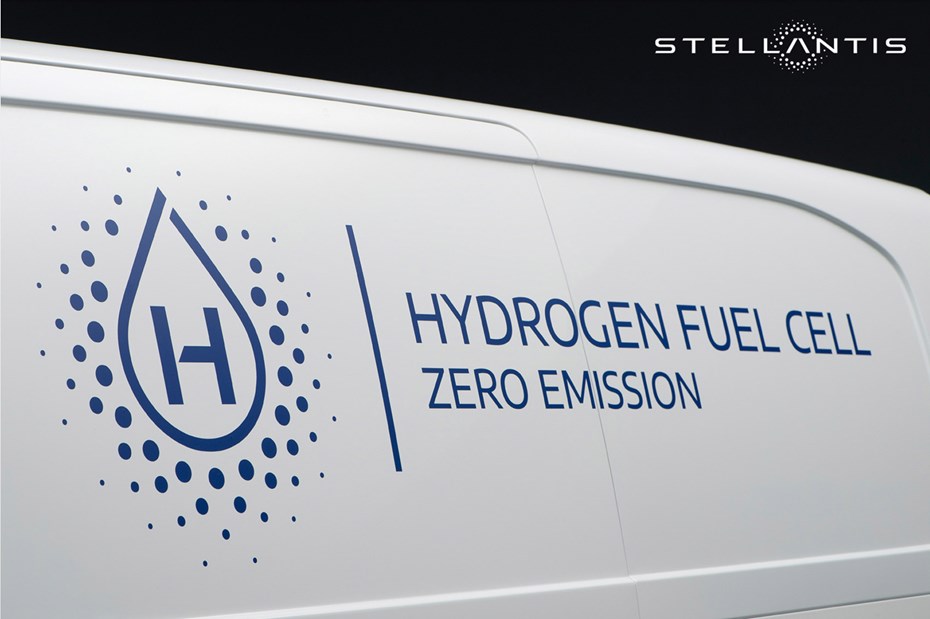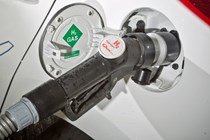Hydrogen has always been the fuel of the future. But Citroen, Peugeot and Opel – the European version of Vauxhall – have announced that business customers in some countries will be able to buy hydrogen-powered vans before the end of 2021.
And while this will be small scale, especially at first, we are talking about proper production hydrogen LCVs (light commercial vehicles) here, rather than prototypes. The first markets will be France and Germany – which are both heavily promoting hydrogen vehicle development at the moment as part of the European Clean Hydrogen Alliance – and initially the hydrogen vans will be left-hand drive only.
This might all still sound like pie-in-the-sky, but the information we have about the technology so far smacks of extremely good thinking. Rather than being ‘full-power’ hydrogen fuel cell vehicles, these new hydrogen vans combine the futuristic tech with present plug-in hybrid electric vehicle (PHEV) production parts in order to deliver a ‘mid-power’ solution that’s more cost-effective and achieves an easily renewed driving range of ‘more than 400km WLTP’.
That’s around 250 miles from a system that can be refuelled in three minutes. If you can find a filling station…
So Citroen, Peugeot and Opel/Vauxhall are working together on hydrogen vans?
All three manufacturers are part of Stellantis, which also owns Fiat among several other well-known brands. The hydrogen vans are a Stellantis project, with Opel in Germany leading on the development – and doing the initial assembly work at Opel Special Vehicles in Ruesselsheim, Germany – and France supporting via Peugeot and Citroen’s expertise in the base vans and two partner companies, Faurecia and Symbio.

At first, only Citroen, Opel and Peugeot will sell the hydrogen vans, which are based on the 100% electric medium van models launched in 2020 (we know these as the Citroen e-Dispatch, Vauxhall Vivaro-e and Peugeot e-Expert).
But Stellantis ended the announcement by saying there would be ‘more to come’, and indeed we now know that the Vauxhall Vivaro-e will follow in 2023.
Isn’t hydrogen a pipe dream? What’s different now?
Stellantis claims this time is different because the vans are being developed to solve a commercial problem – namely that 100% pure electric vans can’t presently work for every customer because they don’t meet daily driving range requirements.
To this end, rather than try and put what’s described as a ‘full power’ hydrogen fuel cell into production, meaning one that would be powerful enough to drive the van on its own, Stellantis is going for a hybrid approach.
This combines a smaller ‘mid-power’ hydrogen fuel cell with a battery pack from the group’s existing plug-in hybrid electric vehicles.
This approach is cheaper (fuel cell technology is very expensive at present, and that’s related to size), easier to package and provides enough power, and allows the system to make use of battery-electric vehicle (BEV) advantages that solve cold-start problems and allow energy recuperation when braking.
How do the Stellantis hydrogen vans work?
They’re built by taking one of the pure electric vans and removing the large battery that’s fitted under the load area. This is replaced by three ultra-strong hydrogen tanks, fitted into a reinforced frame (with underside protection) that bolts to the same mounting points on the body as the removed battery pack. They have a total capacity of 4.4kg of hydrogen, compressed to 700 bar of pressure.
Under the bonnet, a compact hydrogen fuel cell ‘stack’ is installed above the existing electric drive motor. The stack converts the hydrogen into electricity, driving the motor; hydrogen is thought of as such a wonder fuel because the only by-product of this process is water – this is otherwise a zero emissions vehicle, just like a full electric van.
Supplementing the fuel cell, a 10.5kWh battery pack from the Stellantis plug-in hybrid vehicle range is installed under the seats in the cab.
As a result of this, the load area remains exactly the same as on any of these vans; the hydrogen versions will even be offered in two body lengths. As far as we can tell, the only impact on practicality is that you won’t be able to have a double front passenger seat, limiting the panel van variants to two passengers only. As the middle seat in these vans is dreadfully cramped anyway, this isn’t a huge problem.

The fuel cell outputs 45kW (about 61hp) and takes care of most of the driving when cruising. But the advantages to also having a substantial battery pack onboard are many.
For starters, the PHEV battery pack kicks in under acceleration, making sure there’s no loss of performance versus a full electric or diesel van. It’s also energy efficient when you slow down – the recuperation process when braking sends charge back into the battery that would otherwise be lost, helping maximise driving range.
And since fuel cells don’t like starting from cold, the PHEV battery pack is used to drive the van in these conditions until the stack reaches operating temperature. This will allow the Stellantis hydrogen LCVs to function even when it’s -20 degrees Celsius.
Finally, should you run out of hydrogen between filling stations, the PHEV battery pack can offer up to 50km (31 miles) of driving range all by itself as backup. So you won’t get stranded that way.
What’s the driving range and how many hydrogen stations are there?
The combined range of fuel cell and battery pack is said to be more than 248 miles, measured to current WLTP standards.
That isn’t much more that the 211 miles of driving range the pure electric versions of these vans already offer. The difference is that refilling the hydrogen tanks takes just three minutes; a meaningful recharge from the electric models takes at least half an hour – and that requires a fast (expensive) charger and won’t even be to 100%.
There aren’t many hydrogen filling stations in the UK at the moment (around 11 at our best count), but Germany already has 90 (said to be national coverage) and France is at 25 and climbing. Both those countries are currently making a big push on hydrogen, and government funding is helping to fund this Stellantis project.
What about payload and practicality?
The load space is exactly the same as even a diesel model, which means up to 6.1 cubic metres from the longer of the two body sizes.
Maximum payload is quoted at 1,100kg. Less than a diesel alternative, but more than the electric variants when fitted with the largest, longest-range battery pack. And the hydrogen vans will still be able to tow up to 1,000kg.
Is hydrogen safe?
At least as safe as any other van. The tanks are super strong, and there are pressure valves everywhere than can shut down the fuel system as soon as a leak is detected. The tanks are made of a composite material which, in an impact, tends to splinter open slightly rather than fail at one particular point. This allows the hydrogen to leak out slowly instead of dangerously rupturing a metal tank.
And should hydrogen leak, it disperses upwards into the air. Unlike petrol or diesel, which will lie about in a big pool on the ground – in petrol’s case, a highly flammable one.
Any other hydrogen vans on the horizon?
Renault is working on hydrogen LCVs, too, thanks also in part to the current funding and drive from the French government. There have been concepts from others, including Mercedes-Benz and Volkswagen, too.
How much will a hydrogen van cost?
That’s a very good question at the moment. Stellantis believes it can make this a viable product and is planning to sell them to businesses, so it can’t be completely outrageous – using a smaller fuel cell is part of the strategy to keep costs down. When we asked Stellantis exec Richard Meyer, he told us to look at existing hydrogen vehicles for a vague indication of how the vans would be priced in relation to their diesel siblings. The only two currently on sale are the Toyota Mirai and Hyundai Nexo, both of which cost around double what their similarly-sized but conventionally-powered stablemates do.
That’s still a pretty vague way to guess pricing but, if we had to estimate, we’d look around the £60,000 mark.
Despite this, Stellantis is adamant production will start before the end of 2021. We’ve very intrigued, and look forward to learning more.
Also read:
>> VW Crafter HyMotion concept
>> What is a hydrogen fuel cell car?
Just so you know, we may receive a commission or other compensation from the links on this website - read why you should trust us.










